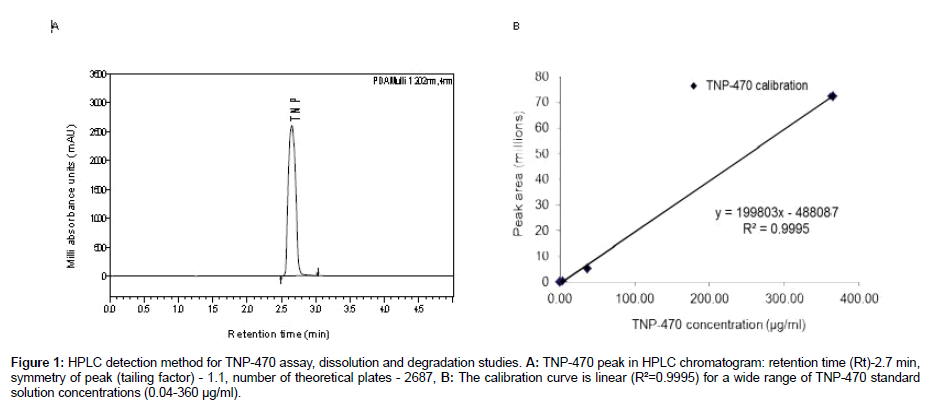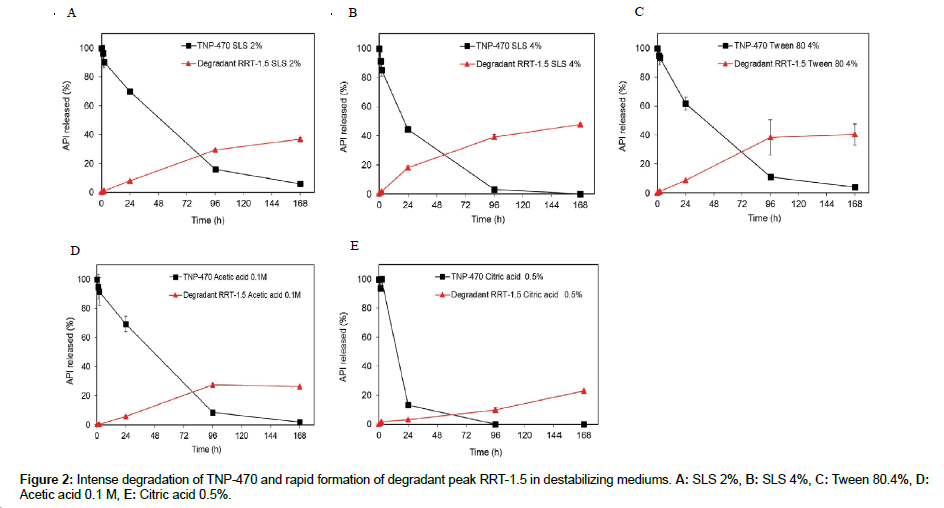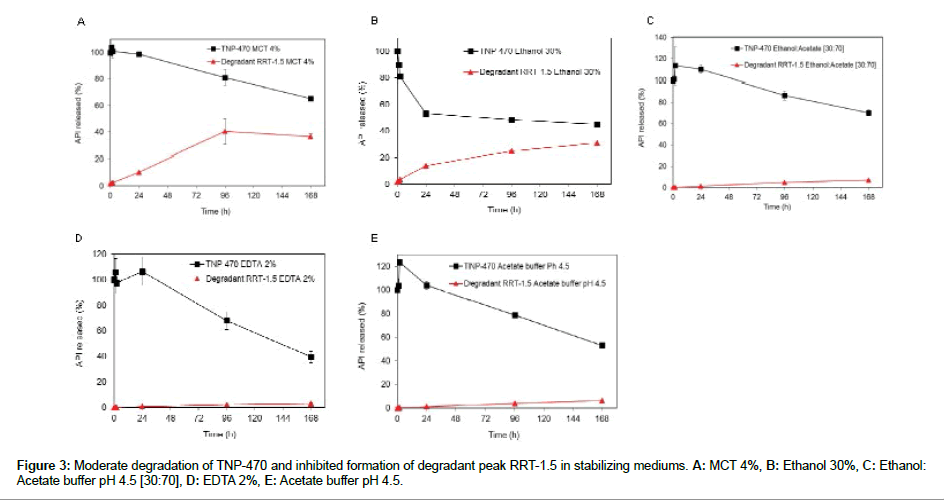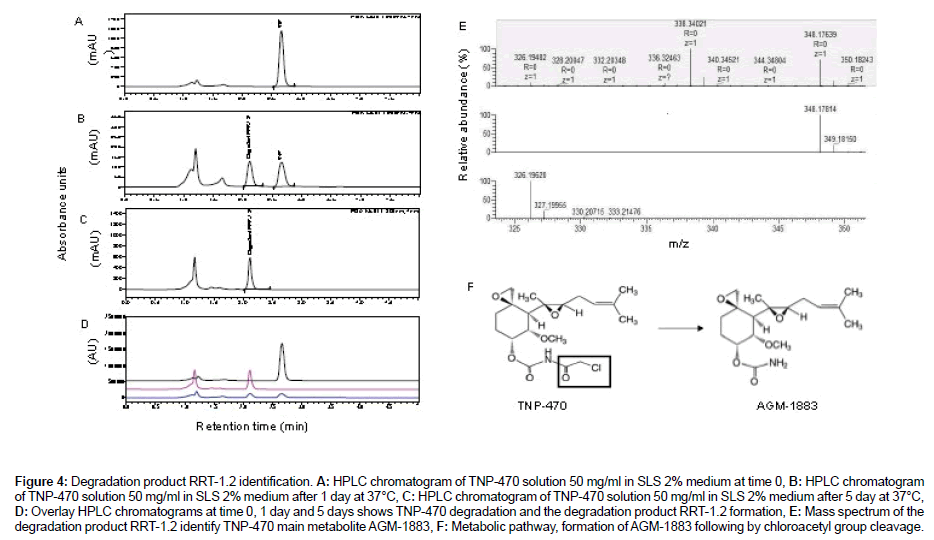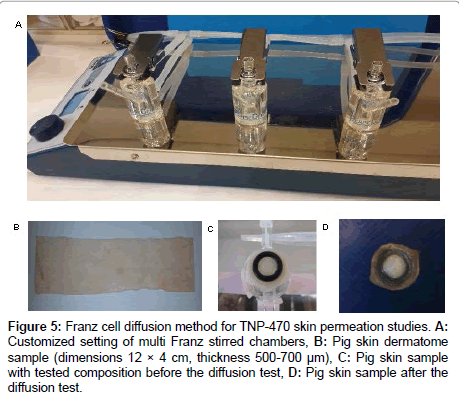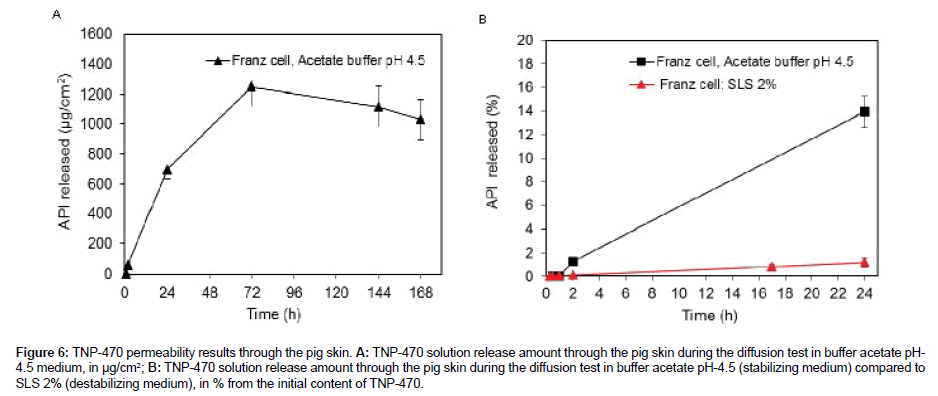Research Article Open Access
Analytical Method for Transdermal Delivery of the Anti-angiogenic Compound TNP-470
Eva Abramov, Ouri Schwob and Ofra Benny*
The Institute for Drug Research, The School of Pharmacy, Faculty of Medicine, The Hebrew University of Jerusalem, Jerusalem, Israel
- *Corresponding Author:
- Ofra Benny
Institute for Drug Research, The School of Pharmacy, Faculty of Medicine
Campus Ein Karem, The Hebrew University, Jerusalem 91120, Israel
Tel: 97226757268
Fax: 97226757273
E-mail: ofrab@ekmd.huji.ac.il
Received date: May 06, 2017; Accepted date: May 19, 2017; Published date: May 24, 2017
Citation: Abramov E, Schwob O, Benny O (2017) Analytical Method for Transdermal Delivery of the Antiangiogenic Compound TNP-470. J Anal Bioanal Tech 8:365. doi:10.4172/2155-9872.1000365
Copyright: © 2017 Abramov E, et al. This is an open-access article distributed under the terms of the Creative Commons Attribution License, which permits unrestricted use, distribution, and reproduction in any medium, provided the original author and source are credited.
Visit for more related articles at Journal of Analytical & Bioanalytical Techniques
Abstract
Pathological angiogenesis is a critical component in cancer, in chronic systemic inflammatory diseases such as psoriasis and rheumatoid arthritis, and in ocular diseases. Anti-angiogenic drugs have the ability to prevent, inhibit, and regress newly formed blood vessels. The activity of TNP-470 (chloro acetylcarbamoylfumagillol), a potent anti-angiogenic drug, has been demonstrated in numerous preclinical studies and in eight clinical studies involving more than three hundred patients. Despite its encouraging efficacy, TNP-470 is unstable compound with short plasma half-life, and, as was found clinically it can cause neurotoxicity side-effects at high doses. In light of these limitations, developing a transdermal drug delivery for TNP-470, can offer a novel and promising clinical usage for this drug by improving its bioavailability, controlled dosage and safety profile. In this work, we developed a reliable method for skin permeation studies of TNP-470, using the pig skin in Franz diffusion cells and High-Performance Liquid Chromatography (HPLC) analysis. Additionally, we performed a broad stability and degradation studies of TNP-470 in different mediums and identify optimal stabilizing conditions in acetate buffer pH-4.5, which can be used for transdermal formulation. Our results demonstrated excellent permeability properties of TNP-470 through the pig skin, where 25% from the initial amount was crossed through the skin membrane after 72 hours. Our results suggesting that TNP-470 is a good candidate for transdermal drug delivery, whereas, an optimal dermal formulation would improve drug’s pharmacokinetic properties and toxicity profile by introducing it in a slow release system.
Keywords
Transdermal delivery; TNP-470; Franz cell; HPLC; Antiangiogenic therapy
Background
Angiogenesis, the formation of new blood vessels, has an essential role in development and reproduction [1]. However, pathological angiogenesis is a critical component in neovascular associated diseases such as cancer, infantile haemangiomas, psoriasis, rheumatoid arthritis and ocular diseases such as age-related macular degeneration [2]. Since angiogenesis is a mutli-step process, several strategies are being developed to target distinct steps which would ultimately interfere in capillary formation. Such anti-angiogenic drugs have the ability to prevent, inhibit, and regress newly formed blood vessels [1,3].
TNP-470 is a synthetic analogue of fumagillin, a natural product secreted by the fungus Aspergillus fumigatus Fresenius [4] which was found by Folkman lab to impair endothelial tube formation [4]. From over 100 synthetic derivatives, TNP-470 was identified as the most potent angiogenic inhibitor, which was 50 times more active than fumagillin and less cytotoxic [5]. The molecular target of TNP-470 was found to be the intracellular enzyme, methionine aminopeptidase 2 (MetAp2) an enzyme responsible for the removal of methionine from newly synthesized proteins [6,7]. MetAp2 is overexpressed in proliferating endothelial cells, and therefore inhibition of MetAp2 leads to selective inhibition of angiogenesis. TNP-470 showed a broad spectrum anticancer activity in numerous preclinical studies and in clinical trials, performed in more than 300 patients, it showed indication of disease stabilization and a few cases of complete remission [8-16].
However, despite its encouraging efficacy, TNP-470 has a several serious limitations for clinical uses. Extremely rapid degradation of TNP-470 in plasma, half-life about 7-8 minutes [14,16] leading to poor pharmacokinetics. TNP-470’s poor oral availability reinforced administration regime of frequent continuous intravenous infusion. Additionally, the dose limiting toxicity involved neurological side effects such as dizziness, decreased concentration, short-term memory loss, confusion and depression [17]. To overcome these limitations pharmacological approaches such as advanced systemic nanoformulations [18] local delivery, or slow release can be used. Transdermal drug delivery can potentially offer a novel and promising clinical usage for TNP-470 for improving its pharmacological properties and safety profile [19].
Transdermal drug delivery is the transport of drugs across the skin into systemic circulation [19]. It has significant advantages over more traditional delivery dosages including controlled drug release and consistent drug levels in the plasma [20]; reduced toxicity due to reduction of drug peak concentrations; improved stability of drugs by avoiding the gastrointestinal tract and first pass metabolism. Additionally, transdermal drug delivery provides an alternative mode of administration to accommodate patients who cannot tolerate oral dosage forms or those who are unconscious. Human skin is the largest organ of the human body and most readily accessible surface for drug delivery which receives about one-third of the blood circulating through the body. However, transdermal drug delivery has also several significant limitations: one of the greatest disadvantages of transdermal drug delivery is the skin's low permeability. The primary function of the stratum corneum, the keratinised outmost layer of the skin, is to provide an outstanding transdermal barrier against the absorption of chemical and biological toxins [21]. This physiological function of the skin substantially limits the ability of drugs to penetrate in this manner through the skin [21-23].
In this work, we demonstrate that TNP-470 can be delivered transdermally and we present the development of an in vitro skin permeation analysis using the pig skin in Franz diffusion cells method which enables the detection of drug transport through the skin membrane [24,25]. We performed a straight forward and robust analytical HPLC method [26] for assay, dissolution and impurity studies of TNP-470. The system suitability parameters of our method meet common U.S. Pharmacopeial Convention (USP) requirements. Additionally, in this work we performed a broad stability and degradation study of TNP- 470 in different mediums and several conditions, and identify such that inhibit the degradation of TNP-470 and stabilize it. This broad investigation is critical for selecting suitable dissolution medium for in vitro studies and for stable transdermal formulation development in future. The degradation product of TNP-470 was detected in HPLC followed by high resolution mass spectrometry.
Our results demonstrated excellent permeability properties of TNP-470 through the pig skin and suggested its suitability for use in transdermal drug delivery system which can improve its pharmacokinetic properties, safety profile and introduce a slow release long-term maintenance anti-angiogenic therapy.
Methods and Materials
HPLC detection method
HPLC analytical method for TNP-470 detection, dissolution and impurity studies was based on the previously published data [26,27] using Shimadzu model LC-20 instrument with Photodiode Array (PDA) detector at 202 nm. The mobile phase consisted of organic phase, acetonitrile (HPLC grade, Baker) and water (HPLC grade, J. Baker). The method robustness was tested on a wide range of acetonitrile:water ratio; different injection volume parameters and flow rate conditions. The chromatographic conditions were robust for 2 different column types: Gemini-NX 5u, C18 110A, 250 × 4.6 mm and XBridge BEH C18, 250 × 5 μm. Initially the method was developed using XBridge BEH column and later was adjusted to Gemini-NX column. The following parameters remained constant during the development: sample temperature -5°C, column temperature -30°C and the wavelength of UV detector -202 nm. The stock standard solution was prepared by weighing about 30 mg of TNP-470 (MedChem partners, MA, USA) and dissolving with acetonitrile in 10 ml volumetric flask. The working standards solutions were prepared by further dilution of the stock solution with acetonitrile for calibration curve linearity test.
Medium solution preparation
The stability and degradation rates of TNP-470 was investigated in 10 different mediums: sodium lauryl sulfate (SLS) 2% solution was prepared by dilution of SLS 20% solution (Innotrain) 10 times; SLS 4% solution was prepared by dilution of SLS 20% solution 5 times; Tween 80 solution 4% was prepared by dissolving of 2 g of Tween 80 (Fisher) in 50 ml of water (HPLC grade, Baker); medium-chain triglyceride(MCT) emulsion 4% was prepared by dispersing of 2 g of MCT (Gattefosse) in 50 ml water, ethanol solution 30% prepared by mixing 9 ml of absolute ethanol (HPLC grade, Baker) with 21 ml water, acetic acid 0.1M was prepared by dilution of 0.3 g of glacial acetic acid (Biolab) with 50 ml water, the checked pH was 2.8; acetate buffer pH-4.5 solution was prepared according to U.S. Pharmacopeial Convention (USP) procedure by dissolving 0.15 g of sodium acetate (Baker) in 50 ml water, adjusted to pH-4.5 by glacial acetic acid; buffer acetate pH-4.5 in ethanol 70% solution was prepared by mixing 21 ml of acetate buffer pH-4.5 with 9 ml ethanol; ehylenediaminetetraacetic acid (EDTA) solution 2% was prepared by dissolving of 1 g of EDTA disodium salt dehydrate (Baker) in 50 ml water; citric acid solution 0.5% was prepared by dissolving of 0.25 g of citric acid (Sigma) in 50 ml water.
Stability and degradation study procedure
The tested sample solution for degradation studies were prepared in duplicate by dilution the TNP-470 stock solution (1 mg/ml) in each medium to obtain the final concentrations of 50 mg/ml in working sample. The working solutions of TNP-470 in different medium were incubated during the experiment in water bath preheated to 37°C and aliquots samples were tested at each time point of 1, 2, 24, 96 and 168 hours, diluted with acetonitrile, injected and detected by HPLC.
Force degradation procedure
In order to detect degradation products of TNP-470 we performed forced TNP-470 decomposition by incubation of TNP-470 solution in acetonitrile: water [50:50] in 50°C for 3 days. After complete decomposition TNP-470, the isolated degradant solution was lyophilized for 24 hours and stored at 4°C. The obtained white powder was used for identification in mass spectrometric analysis.
Mass spectrometric analysis
Mass spectrometric analysis of TNP-470 degradant was carried out with an LTQ Orbitrap XL mass analyzer (ThermoFisher Scientific) employing positive-mode electrospray ionization. The instrument was fully calibrated prior to all measurements according to manufacturer's instructions. The measurements were performed at a resolution of 30,000. All FT scans consisted of 15 microscans. The acquired spectra were evaluated using Xcalibur 2.1 software.
Franz cell method
In vitro and ex vivo studies enable the detection of drug concentration in the skin, penetration, rate of drug transport across the skin and permeation. Ex vivo skin permeation studies are commonly performed using the Franz diffusion cells method [25]. We used a customized setting of multi Franz stirred chambers in order to perform experiments in parallel. The Franz cell apparatus consists of two primary units, the donor and receptor chambers, separated by a membrane. We used standard O-ring Franz cells (PermeGear), with receptor volume of 5 ml and surface area of orifice area of 0.2 cm2. The tested solution is added to the upper chamber, the bottom chamber contains dissolution medium from which samples are withdrawn at different time points, diluted with acetonitrile, injected and detected by HPLC. The amount of drug that crossed the membrane is determined at each time point according to calibration curve of TNP-470. The membrane we used was pig's ears skin dermatome with thickness of 500-700 μm purchased from the Institute of Animal Research (Kibbutz Lahav).
Results
HPLC method development
The robustness of following parameters of the method was tested during the development: injection volume, mobile phase, flow rate, column manufactures. Mobile phase robustness was tested on different ratios of acetonitrile: water- 50:50, 60:40, 70:30, and 80:20. As expected, the retention time (Rt) of TNP-470 varied according to mobile phase: from Rt - 2.7 min, in case of high content of organic phase acetonitrile in mobile phase to Rt - 6.3 min in case of low content of acetonitrile in mobile phase as we can see in Figure 1A. The symmetry factor value, tailing factor, of the TNP-470 peak was around 1.0 and the number of theoretical plates was around 2500 in different conditions. The flow rate of the mobile phase was changed from 1 to 2 ml/min. The robustness of different injection volume parameters was measured in 10, 20, 30 μl. Different sets of standards solutions were prepared for linearity determination of different chromatographic conditions. For example, Figure 1B show the calibration curve for a wide range of TNP-470 concentrations, from 0.04 to 360 μg/ml. The calibration curve linearity factor - R² was 0.9995 for injection volume 30 μl and 0.9967 for injection volume 10 μl. For most tested chromatographic conditions the calibration curve linearity factor- R² was more than 0.99. The repeatability test was performed for 5 injections and relative standard deviation (RSD) was found 0.4%. The stability of the working standard solutions was verified for 5 days at cooling conditions 5ºC, the RSD for 5 injections was found around 1.5%.
Figure 1: HPLC detection method for TNP-470 assay, dissolution and degradation studies. A: TNP-470 peak in HPLC chromatogram: retention time (Rt)-2.7 min, symmetry of peak (tailing factor) - 1.1, number of theoretical plates - 2687, B: The calibration curve is linear (R²=0.9995) for a wide range of TNP-470 standard solution concentrations (0.04-360 μg/ml).
Stability and degradation study of TNP-470 in different mediums
In order to assess the stability of TNP-470 in different conditions, the degradation rates of TNP-470 was investigated in 10 different mediums: sodium lauryl sulfate (SLS) 2%, SLS solution 4%, Tween 80 solution 4%, MCT emulsion 4%, ethanol solution 30%, acetic acid 0.1M, buffer acetate pH-4.5 in ethanol 70%, EDTA solution 2%, citric acid solution 0.5%, acetate buffer pH-4.5 solution. The specific mediums were selected to find conformed dissolution medium for skin penetration studies and to find stabilizing and destabilizing factors for future formulation development of TNP-470. According to TNP- 470 stability results we can sort the mediums to two main categories, stabilizing and destabilizing mediums.
The first category of destabilizing mediums, which included SLS 2%, SLS 4%, Tween 80 4%, acetic acid 1M and citric acid solution 0.5%, characterized by intensive degradation of TNP-470, see Figure 2A-2E. The assay of TNP-470 decreased to 70% in SLS 2%, 45% in SLS 4%, 62% in Tween 80 4%, 69% in acetic acid 0.1M and 13% in citric acid after 24 hours, about 10% of TNP-470 remained after 96 hours and after 168 hours the TNP-470 peak was not detected in all mediums of destabilizing category. Additionally, we observed that TNP-470 peak decrease was followed by unknown peak formation which was detected at Relative Retention Time, RRT-1.5 related to TNP-470. The intensive degradation and decrease in TNP-470 assay resulted in rapid growing of its degradation product peak, degradant RRT-1.5, see Figure 2A-2E. After 168 hours when the assay of TNP-470 peak dropped from 100 to 0% the assay of its degradant RRT-1.5 peak increased in average from 0 to 35% in the destabilizing category mediums.
The second category of stabilizing mediums, which included MCT 4%, ethanol 30%, buffer acetate pH-4.5 ethanolic solution 70%, EDTA 2%, acetate buffer pH-4.5, characterized by moderate degradation of TNP-470, see Figure 3A-3E. The assay of TNP-470 after 24 hours was found 99% in MCT 4%, 53% in ethanol 30%, 110% in buffer acetate pH- 4.5 in ethanol 70%, 107% in EDTA 2%, and 104% in acetate buffer pH- 4.5. Around 80% of TNP-470 remained after 96 hours in all stabilizing mediums except ethanol 30% solution where assay of TNP-470 was found around 50%. Finally, after 168 hours the assay of TNP-470 remained about 50% in stabilizing category mediums. The degradant RRT-1.5 peak formation was detected also in stabilizing category mediums however its increase was moderate, see Figure 3A-3E. After 168 hours when the assay of TNP-470 peak decreased from 100 to 50% the assay of its degradant RRT-1.5 peak increased in average from 0 to 5%, except ethanol 30% and MCT 4% solutions, where the raise was more significant, from 0 to 35%.
TNP-470 degradation product identification
The degradation of TNP -470 was associated with formation of TNP-470 degradation product. The rate of TNP-470 degradation and its degradation product formation varied in different buffers. Figure 4A shows a single peak in chromatogram of TNP-470 when sample is fresh in SLS 2% without detectable degradation peak. In Figure 4B after 1 day at 37°C the height of degradant peak was equal to TNP-470 peak. After 5 days, as shown in Figure 4C all TNP-470 was degraded with a clear peak of degradation product. The overlaid chromatograms of described samples solutions are shown in Figure 4D. The RRT value of TNP-470 degradation product varied from 1.2 to 1.5 related to TNP-470 according to chromatographic conditions. With the decrease of organic part, acetonitrile to 50% in mobile phase, the RRT value increased to 1.5, and with increase of organic part to 80% the distance between two peaks reduced to RRT-1.2.
Figure 4: Degradation product RRT-1.2 identification. A: HPLC chromatogram of TNP-470 solution 50 mg/ml in SLS 2% medium at time 0, B: HPLC chromatogram of TNP-470 solution 50 mg/ml in SLS 2% medium after 1 day at 37°C, C: HPLC chromatogram of TNP-470 solution 50 mg/ml in SLS 2% medium after 5 day at 37°C, D: Overlay HPLC chromatograms at time 0, 1 day and 5 days shows TNP-470 degradation and the degradation product RRT-1.2 formation, E: Mass spectrum of the degradation product RRT-1.2 identify TNP-470 main metabolite AGM-1883, F: Metabolic pathway, formation of AGM-1883 following by chloroacetyl group cleavage.
To further identify the main degradation product of TNP-470 we performed mass spectrometry analysis. Mass spectrogram of the isolated and purified TNP-470 degradation product is shown in Figure 4E. According to high resolution mass spectrum the TNP-470 degradation product was identified as one of its main metabolites of TNP-470, AGM- 1883 [27,28]. The metabolic pathway of TNP-470 and formation of AGM- 1883 following by chloroacetyl group cleavage is shown in Figure 4F.
TNP-470 skin permeation study
In vitro skin permeation study was performed using Franz cell method [25]. The customized setting of multi Franz stirred chambers is shown at Figure 5A. The Franz cell apparatus consists of two primary units, the donor and receptor chambers, separated by a membrane. As a membrane, we used pig skin dermatome with uniform thickness of 500-700 micron, as shown in Figure 5B and 5D. The tested solution was added to the upper chamber as shown in Figure 5C and the bottom chamber contained dissolution medium from which samples were taken at different time points for analysis. After the stability and degradation study, we perform the Franz permeability assay using acetate buffer pH 4.5 stabilizing medium and compare the results to SLS 2%, destabilizing method. The amount of drug permeated the skin was sampled and determined in four time points by HPLC detection method. The released amount of TNP-470 in acetate buffer pH-4.5 medium is shown in Figure 6A. The amount of TNP-470 which crossed through the pig skin membrane is presented in μg per skin area (cm2) plotted in each time point (hours). A maximum value of 1250 μg/cm2 TNP-470 was obtained after 72 hours which is 25% from the initial amount. In Figure 6B the released amount of TNP-470 in acetate buffer pH-4.5 medium is presented in % from the initial amount and compared to results in SLS 2% medium in the same conditions. The skin permeability values of TNP-470 sampled in acetated buffer after 24 hours was 14% compared to permeability value in SLS 2% which was only 1%.
Figure 5: Franz cell diffusion method for TNP-470 skin permeation studies. A: Customized setting of multi Franz stirred chambers, B: Pig skin dermatome sample (dimensions 12 × 4 cm, thickness 500-700 μm), C: Pig skin sample with tested composition before the diffusion test, D: Pig skin sample after the diffusion test.
Figure 6: TNP-470 permeability results through the pig skin. A: TNP-470 solution release amount through the pig skin during the diffusion test in buffer acetate pH- 4.5 medium, in μg/cm2; B: TNP-470 solution release amount through the pig skin during the diffusion test in buffer acetate pH-4.5 (stabilizing medium) compared to SLS 2% (destabilizing medium), in % from the initial content of TNP-470.
Discussion
Anti-angiogenic drugs have the ability to modify or regress newly formed blood vessels. Several forms of angiogenesis inhibitors exist, ranging from endogenous proteins and small molecule cytokine antagonists, to antibodies and tyrosine kinase inhibitors [3,29-31]. Historically, the main target of anti-angiogenic drugs in clinical development has been blocking the Vascular Endothelial Growth Factor (VEGF) pathways. However, other angiogenic factors also play critical roles in neovascularization; in addition, most neovascular diseases are accompanied by inflammation and involve several proinflammatory cytokines with VEGF independent mechanisms (such as MCP-1, IL-6, TNFα). These alternative pathways substantially limit the therapeutic index of solely anti-VEGF drugs. Therefore, using strategies to administer broad spectrum angiostatic agents, such as TNP-470, that have molecular target downstream to VEGF may have an important therapeutic advantage. Moreover, small molecules can potentially penetrate the skin, unlike macromolecules [21,32].
In this work, we introduced for the first time the transdermal delivery of TNP-470. We systematically studied the potential of using MetAp2 inhibitor in a transdermal formulation and established a reliable skin permeation assay using Franz diffusion cells method, which enables the detection of drug transport through the skin and quantitation the permeated amount of the drug. For this reason, we developed a simple analytical HPLC method for assay, dissolution and impurity studies of TNP-470. The TNP-470 peak parameters, symmetry factor and number of theoretical plates, conformed a common U.S. Pharmacopeial Convention (USP) requirements (Figure 1A). According to the calibration curve linearity factor, R²=0.9995, the developed method is linear for a wide range of TNP-470 concentrations (Figure 1B). The repeatability test, the RSD for 5 injections was found less than 2% which also conformed to common USP system suitability test requirements. Additionally, the method was found robust for a wide range of chromatographic parameters: injection volume, mobile phase, flow rate and different types of column, which enables its wide and universal application.
In this study, we investigated the stability and degradation of TNP- 470 in 10 different mediums. The specific list of mediums was selected both for analytical purposes, to find suitable dissolution medium for in vitro skin penetration studies and for future formulation development, to find stabilizing and destabilizing factors for TNP-470. According to TNP-470 stability results we can sort the mediums to two main categories, stabilizing and destabilizing mediums (Figures 2 and 3). The first group of destabilizing mediums, which included SLS 2%, SLS 4%, Tween 80 4%, acetic acid 0.1M and citric acid solution 0.5%, characterized by intensive decomposition of TNP-470 followed by degradation product peak formation which was detected at relative retention time RRT-1.5 related to TNP-470 (Figure 2).
The second group of stabilizing mediums, which included MCT 4%, ethanol 30%, buffer acetate pH-4.5 ethanolic solution 70%, EDTA 2%, acetate buffer pH-4.5, characterized by moderate degradation of TNP-470 followed by insignificant degradant peak formation (Figure 3). It is known that TNP-470 is stable in organic solvents and undergoes rapid hydrolysis in the presence of water [26,27,33] which explains its rapid degradation in aqueous solution of SLS 2%, SLS 4% and Tween 80 4% and relative stability in ethanol 30%. The stability of TNP-470 in MCT could be explain by solubility of highly lipophilic drug TNP-470 in MCT, lipid compound and it is supposed that water could not so easily access the TNP-470 surrounded by fat and oil molecules. Our stability results of TNP-470 in MCT 4% emulsion supports previous microspheres formulation development containing TNP-470 with MCT performed by Kakinoki et al. [34].
Relative stability of TNP-470 in buffer acetate pH-4.5, EDTA 2% and buffer acetate pH-4.5 ethanolic solution 70% led us to believe that we found stabilizing agent of TNP-470 acetate ion, CH3COO−, which presented in all 3 solutions. Unfortunately, this hypothesis disproved by rapid degradation of TNP-470 in acetic acid 0.1M, pH-2.8. This fact led us to understanding that the main stabilizing factors of TNP-470 in aqueous solutions is pH. Our findings correlated to previous study performed by Figg et al. suggested that TNP-470 would be most stable in a slightly acidic medium, pH 4-5 [27]. Although the stability of TNP- 470 was almost equivalent in MCT 4%, buffer acetate pH-4.5 and buffer acetate pH-4.5 ethanolic solution 70%, we selected buffer acetate pH- 4.5 as dissolution medium for in vitro skin permeation studies because it is common buffer solution accepted by US pharmacopeia and most approximate to physiological environment conditions.
We performed TNP-470 in vitro skin permeation study using Franz cell method in selected dissolution medium, stabilizing buffer acetate pH-4.5 and compared the results to the destabilizing medium, SLS 2%. Skin's protective function provides an outstanding transdermal barrier which limits the penetration of drugs through the skin and usually most transdermal patches after removal contain at least 95% of the total amount of drug initially in the patch, which means that only 5% from the initial amount permeate the skin [19,20]. In light of this facts, the TNP-470 permeability results through the pig skin, 1250 μg/cm2 after 72 hours which is 25% from the initial amount (Figure 6A), demonstrate excellent delivery of TNP-470 via transdermal route. The great difference between permeability results in two different dissolution mediums, stabilizing buffer acetate pH-4.5 and destabilizing SLS 2%, highlights the significance of TNP-470 stability studies and the importance of appropriate dissolution medium selection. In the acetate buffer pH-4.5 the permeated amount of TNP-470 after 24 hours was 14% compared to only 1% in SLS 2% (Figure 6B). It is obvious that the negligible amount of TNP-470 detected in SLS 2% was associated with degradability of TNP-470 in this medium and well correlated to stability studies we performed where destabilizing mediums group which included SLS 2% characterized by intensive decomposition of TNP-470.
Conclusion
This study demonstrates a simple reliable method for skin permeation studies of TNP-470, a potent anti-angiogenic drug, using Franz diffusion cells and HPLC detection methods. Our results introduce TNP-470 excellent candidature to transdermal drug delivery, which can offer a novel and promising clinical usage for potent antiangiogenic drug to improve its poor bioavailability and safety profile, caused by peak concentration of the drug in plasma. Additionally, our study provides a broad data of TNP-470 stability in different mediums, which can lead to stable and improved formulation development in future. Taking together our findings can lead to the development of slow release transdermal delivery system, which may be used as a long-term maintenance therapy for angiogenesis-dependent diseases such as cancer, psoriasis, rheumatoid arthritis and age-related macular degeneration.
References
- Folkman J (2007) Angiogenesis: an organizing principle for drug discovery. Nat Rev Drug Discov 6: 273-286.
- Miller JW, Adamis AP, Shima DT, D'Amore PA, Moulton RS, et al. (1994) Vascular endothelial growth factor/vascular permeability factor is temporally and spatially correlated with ocular angiogenesis in a primate model. Am J Pathol 145: 574-584.
- Folkman J (1997) Angiogenesis and angiogenesis inhibition: An overview. Exs 79: 1-8.
- Ingber D, Fujita T, Kishimoto S, Sudo K, Kanamaru T, et al. (1990) Synthetic analogues of fumagillin that inhibit angiogenesis and suppress tumour growth. Nature 348: 555-557.
- Figg WD, Pluda JM, Lush RM, Saville MW, Wyvill K, et al. (1997) The pharmacokinetics of TNP-470, a new angiogenesis inhibitor. Pharmacotherapy 17: 91-97.
- Chun E, Han CK, Yoon JH, Sim TB, Kim YK, et al. (2005) Novel inhibitors targeted to methionine aminopeptidase 2 (MetAP2) strongly inhibit the growth of cancers in xenografted nude model. Int J Cancer 114: 124-130.
- Griffith EC, Su Z, Niwayama S, Ramsay CA, Chang YH, et al. (1998) Molecular recognition of angiogenesis inhibitors fumagillin and ovalicin by methionine aminopeptidase 2. Proc Natl Acad Sci USA 95: 15183-15188.
- Bhargava P, Marshall J, Rizvi N, Dahut W, Yoe J, et al. (1999) A phase I and pharmacokinetic study of TNP-470 administered weekly to patients with advanced cancer. Clin Cancer Res 5: 1989-1995.
- Herbst R, Madden T, Tran H, Blumenschein GJ, Meyers C, et al. (2002) Safety and pharmacokinetic effects of TNP-470, an angiogenesis inhibitor, combined with paclitaxel in patients with solid tumors: evidence for activity in non-small-cell lung cancer. J Clin Oncol 20: 4440-4447.
- Kruger E, Figg WD (2000) TNP-470: an angiogenesis inhibitor in clinical development for cancer. Expert Opin Investig Drugs 9: 1383-1396.
- Kudelka A, Levy T, Verschraegen C, Edwards C, Piamsomboon S, et al. (1997) A phase I study of TNP-470 administered to patients with advanced squamous cell cancer of the cervix. Clin Cancer Res 3: 1501-1505.
- Kudelka A, Verschraegen C, Loyer E (1998) Complete remission of metastatic cervical cancer with the angiogenesis inhibitor TNP-470. N Engl J Med 338: 991-992.
- Logothetis C, Wu K, Finn L, Daliani D, Figg W, et al. (2001) Phase I trial of the angiogenesis inhibitor TNP-470 for progressive androgen-independent prostate cancer. Clin Cancer Res 7: 1198-1203.
- Moore JD, Dezube BJ, Gill P, Zhou XJ, Acosta EP, et al. (2000) Phase I dose escalation pharmacokinetics of O-(chloroacetylcarbamoyl) fumagillol (TNP-470) and its metabolites in AIDS patients with Kaposi's sarcoma. Cancer Chemother Pharmacol 46: 173-179.
- Stadler W, Kuzel T, Shapiro C, Sosman J, Clark J, et al. (1999) Multi-institutional study of the angiogenesis inhibitor TNP-470 in metastatic renal carcinoma. J Clin Oncol 17: 2541-2545.
- Tran H, Blumenschein GJ, Lu C, Meyers C, Papadimitrakopoulou V, et al. (2004) Clinical and pharmacokinetic study of TNP-470, an angiogenesis inhibitor, in combination with paclitaxel and carboplatin in patients with solid tumors. Cancer Chemother Pharmacol 54: 308-314.
- Kruger EA, Figg WD (2000) TNP-470: an angiogenesis inhibitor in clinical development for cancer. Expert Opin Investig Drugs 9: 1383-1396.
- Benny O, Fainaru O, Adini A, Cassiola F, Bazinet L, et al. (2008) An orally delivered small-molecule formulation with antiangiogenic and anticancer activity. Nature Biotechnology 26: 799-807.
- Schoellhammer CM, Blankschtein D, Langer R (2014) Skin permeabilization for transdermal drug delivery: recent advances and future prospects. Expert Opin Drug Deliv 11: 393-407.
- Gupta H, Babu RJ (2013) Transdermal delivery: product and patent update. Recent Pat Drug Deliv Formul 7: 184-205.
- McLafferty E, Hendry C, Alistair F (2012) The integumentary system: anatomy, physiology and function of skin. Nurs Stand 27: 35-42.
- Ita KB (2015) Chemical penetration enhancers for transdermal drug delivery- success and challenge. Curr Drug Deliv.
- Jain A, Jain P, Kurmi J, Jain D, Jain R, et al. (2014) Novel strategies for effective transdermal drug delivery: a review. Crit Rev Ther Drug Carrier Syst 31: 219-272.
- Lehman PA, Raney SG, Franz TJ (2011) Percutaneous absorption in man: in vitro-in vivo correlation. Skin Pharmacol Physiol 24: 224-230.
- Bartosova L, Bajgar J (2012) Transdermal drug delivery in vitro using diffusion cells. Curr Med Chem 19: 4671-4677.
- Whalen CT, Hanson GD, Putzer KJ, Mayer MD, Mulford DJ (2002) Assay of TNP-470 and its two major metabolites in human plasma by high-performance liquid chromatography-mass spectrometry. J Chromatogr Sci 40: 214-218.
- Figg WD, Yeh HJ, Thibault A, Pluda JM, Itoh F, et al. (1994) Assay of the antiangiogenic compound TNP-470, and one of its metabolites, AGM-1883, by reversed-phase high-performance liquid chromatography in plasma. J Chromatogr 652: 187-194.
- Ong VS, Stamm GE, Menacherry S, Chu S (1998) Quantitation of TNP-470 and its metabolites in human plasma: sample handling, assay performance and stability. J Chromatogr B Biomed Sci Appl 710: 173-182.
- Folkman J (1996) Fighting cancer by attacking its blood supply. Scientific American 275: 150.
- Folkman J (1996) Tumor angiogenesis and tissue factor. Nature Medicine 2: 167-168.
- Folkman J (1995) Angiogenesis inhibitors generated by tumors. Molecular Medicine 1: 120-122.
- Wiedersberg S, Guy R (2014) Transdermal drug delivery: 30+ years of war and still fighting. Journal of Controlled Release 190: 150-156.
- Ong V, Stamm G, Menacherry S, Chu S (1998) Quantitation of TNP-470 and its metabolites in human plasma: sample handling, assay performance and stability. Journal of Chromatography B 710: 173-182.
- Kakinoki S, Yasuda C, Kaetsu I, Uchida K, Yukutake K, et al. (2003) Preparation of poly-lactic acid microspheres containing the angiogenesis inhibitor TNP-470 with medium-chain triglyceride and the in vitro evaluation of release profiles. Eur J Pharm Biopharm 55: 155-160.
Relevant Topics
Recommended Journals
Article Tools
Article Usage
- Total views: 5937
- [From(publication date):
June-2017 - Aug 29, 2025] - Breakdown by view type
- HTML page views : 4982
- PDF downloads : 955

